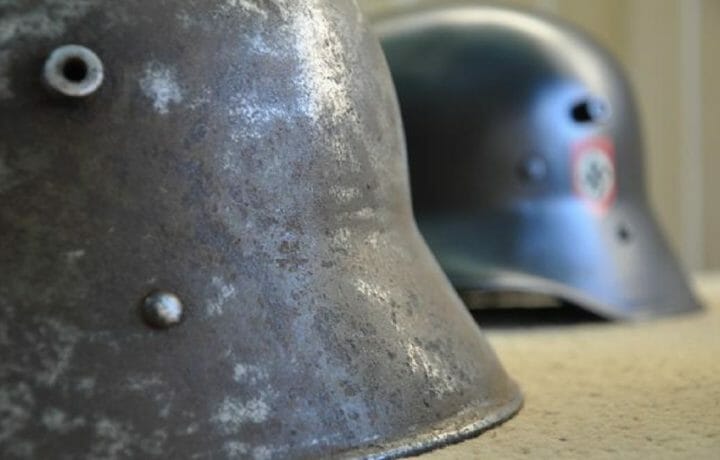Combat helmets designed during the First World War more than 100 years ago provided better protection from shockwaves than those modern helmets being used in conflicts around the world. That was the finding of a Duke University study released earlier this month and published in the journal PLOS ONE.
While helmets have been used since antiquity, by the outbreak of World War I these had largely disappeared from the battlefield – relegated mostly to ceremonial uses. When the armies marched off to war in Europe only the cavalry units of Austria-Hungary, Belgium, France, Germany and Russia were actually equipped with helmets as part of the “combat” uniform. However, within a year, steel skull caps followed closely by helmets were developed for use by the infantry.
Since WWI helmets have remained part of the military uniform, but only recently have the concerns of concussions from blunt trauma been explored. For most of the 20th and even into the early 21st century, the helmet’s primary function was to provide protection from low velocity (artillery blasts such as shrapnel) and when possible, high velocity (ballistic protection from small arms rounds).
The Duke study compared the blast-protective effect of historical combat helmets dating back 100 years to those employed by various military powers today. The helmets included WWI helmets from the United Kingdom/United States, the Brodie (named after its inventor John Brodie) and MkI/M1917; the French M1915 or “Adrian” (also named after its inventor General August-Louis Adrian); and the German M1916/17 “Stahlhelm.” These were compared to the current Advanced Combat Helmet (ACH) used by the United States.
For the tests, helmets were mounted on a dummy head and neck, which was aligned along the crown of the head with a cylindrical shock tube to simulate an overhead blast. The tests include blast waves of different magnitudes, which were meant to simulate the blast conditions from historical artillery shells.
Blasts or shockwaves can result in pulmonary trauma, also known as chest trauma – and improved body armor has led to a decline in such trauma in combat. However, the waves can also cause traumatic brain injuries, something the helmet designers 100 years ago likely didn’t consider.
The study found that the modern ACH did not provide more pressure attenuation than the historical helmets, and moreover, that some of the historical helmets performed better at certain measurement locations. The French M1915 helmet actually offered the least risk for brain bleeding of all the helmets tested. It is notable that it featured a metal “comb” over the dome of the helmet, which was originally intended to defect saber blows.
The French infantry helmet designed by General Adrian was actually based on the Parisian firefighters’ helmets, which were in turn based on the cavalry helmets.
“The result is intriguing, because the French helmet was manufactured using similar materials as its German and British counterparts, and even had a thinner wall,” lead researcher Joost Op’t Eynde said in a press release. “The main difference is that the French helmet had a crest on top of its crown. While it was designed to deflect shrapnel, this feature might also be deflecting shock waves.”
As a result, the study’s authors noted that “simple design features may improve these capabilities for future helmet systems.”
There have already been efforts by some of the manufacturers of the modern combat helmets to help construct a better liner system as a way to address concussions and other traumatic brain injuries.
“Shockwaves and other injury mechanisms, such as rotational trauma, are areas that are under constant evaluation by our team,” said Marnie Blanshay, director of marketing and communications at Galvion, maker of protective armor and head systems for the modern warfighter.
“It is expected our liner technologies will evolve as active research into these injury mechanisms is reviewed and assessed and mitigation options incorporated,” Blanshay told ClearanceJobs.
More importantly, it should be remembered that the Adrian and British Brodie/MkI design came out of a need to specifically address artillery blasts that soldiers in the trenches faced in the middle stages of the First World War. Today’s warfighters face threats that are very different.
“Duke’s conclusion is something we should all pay attention to, for sure, but keep in mind they specifically examined overhead blasts,” said Ron Szalkowski, Team Wendy’s director of product development and research collaboration.
“This might not translate to other scenarios, and the authors admit to complications with shockwaves emanating from an IED blast,” Szalkowski told ClearanceJobs.
He noted that additional protection is always something the industry should be working toward, and suggested said advancements will follow in earnest once researchers are able to more accurately model brain response inside the skull, instead of merely modeling surface pressure on a person’s head.
“Blasts coming in from a horizontal direction or from below – that’s really where this can be applied. We want to make sure the helmet deflects the wavefront, instead of ‘cupping,’ or ‘catching it.'”




